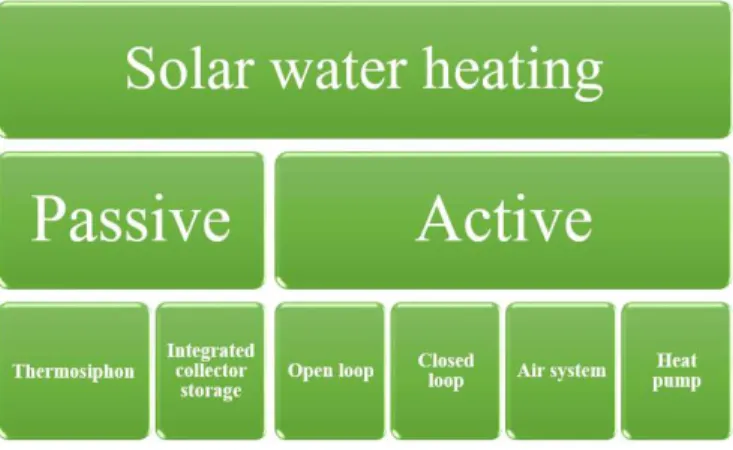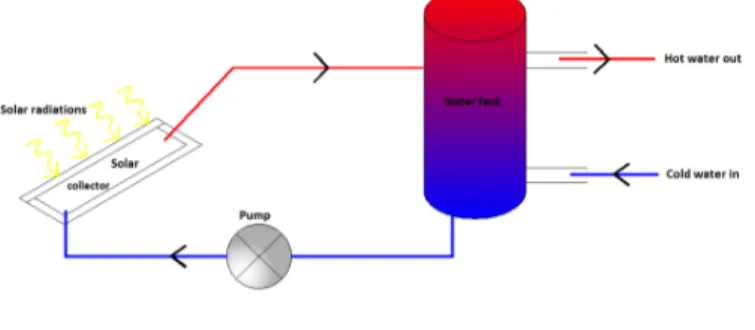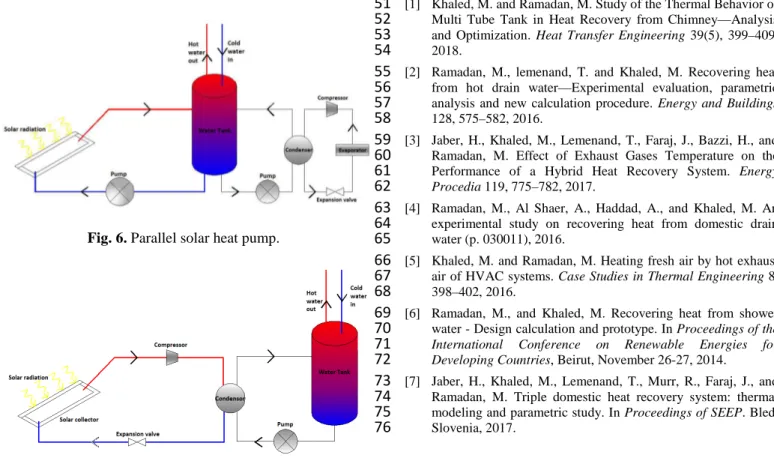HAL Id: hal-02568375
https://hal.univ-angers.fr/hal-02568375
Submitted on 9 May 2020
HAL is a multi-disciplinary open access
archive for the deposit and dissemination of sci-entific research documents, whether they are pub-lished or not. The documents may come from teaching and research institutions in France or abroad, or from public or private research centers.
L’archive ouverte pluridisciplinaire HAL, est destinée au dépôt et à la diffusion de documents scientifiques de niveau recherche, publiés ou non, émanant des établissements d’enseignement et de recherche français ou étrangers, des laboratoires publics ou privés.
Review on Solar Water Heating System
Amal Herez, M. Khaled, H. El Hage, Thierry Lemenand, M. Ramadan
To cite this version:
Amal Herez, M. Khaled, H. El Hage, Thierry Lemenand, M. Ramadan. Review on Solar Water Heating System. International Conference on Emerging and Renewable Energy: Generation and Automation ICEREGA 2018, Oct 2018, Sousse, Tunisia. �hal-02568375�
Review on Solar Water Heating System
1A. Herez1, M. Khaled1,2, H. EL Hage1, T. Lemenand3*and M. Ramadan1,4*
2
1 International University of Beirut, BIU, PO Box 146404 Beirut, Lebanon
3
2Univ Paris Diderot, Sorbonne Paris Cité, Interdisciplinary Energy Research Institute (PIERI), Paris, France
4
3
LARIS EA 7315, University of Angers − ISTIA, Angers, France
5
4Associate member at FCLAB, CNRS, Univ. Bourgogne Franche-Comte, Belfort cedex, France.
6 7 *mohamad.ramadan@liu.edu.lb 8 9 10
Abstract. Solar water heating is a promising application of solar energy. It utilizes this renewable energy to produce hot water
11
that can be used for several purposes and in different places (houses, hotels, hospitals, etc.). Such application serves in mitigating
12
the dependence on conventional energy sources that are depleting day after day and replace it by using renewable source of
13
energy which is environmentally friendly. The aim of this paper is to present a brief review on solar water heating systems. The
14
review includes demonstration of the principle of solar water heating systems. Also, classification of such system is exposed in
15
addition to the mode of operation of each type.
16 17
1. Introduction
18
The continues aggravation of environmental problems
19
in addition to the persistent increase in the cost of
20
conventional sources of energy motivated scientific
21
researchers to exploit heat recovery systems or
22
renewable energy sources as effective solutions. Heat
23
recovery systems [1-11] are defined as the reuse of the
24
dissipated energy from distinct application leading to
25
the increase of energy usage efficiency. On the other
26
hand, renewable sources of energy mainly comprise
27
geothermal [12], wind [13], biomass [14] and solar
28
energy [15-20]. Solar energy is a distinguished type of
29
renewable energy sources where several applications are
30
derived from it. Solar water heating system [21-23] is a
31
fascinating idea to exploit solar energy. It absorbs solar
32
energy and transforms thermal energy into heat to
33
generate hot water which can be used for domestic and
34
industrial purposes.
35
The target of this paper is to expose a brief review on
36
solar water heating system regarding its principle of
37
work, classification and the mode of operation of each
38
type of this application. Hence, the rest of the paper is
39
organized as follows: section 2 explains the principle of
40
solar water heating system, section 3 presents the
41
classification of such system and investigates the mode
42
of function of each type and section 4 summarizes the
43
main conclusions of this paper.
44 45
2. Principle of solar water heating application
46
Solar water heating system is composed of solar
47
collector, tank, pipelines, and working fluid. In such
48
system, fluid is heated by transporting it in contact with
49
dark surface which is imposed to solar radiation. This
50
dark surface is the solar collector in which its role to
51
absorb solar radiation and reduce heat loss. In solar
52
water heating systems, the fluid may be either water
53
which will be heated and utilized directly, or heat
54
transfer fluid such as glycol/water that will pass through
55
form of heat exchanger and heat water to be used. Fig. 1
56
shows a schematic that summarizes the process of
57
heating water using solar energy.
58 59 60 61
Fig. 1. Process of heating water using solar energy. 62
63
3. Classification of solar water heating system
64
Solar water heating system is generally classified into
65
two systems; passive and active systems. Fig.2
66
illustrates the technologies of each type of solar water
67 heating systems [24]. 68 69 70 71
Fig. 2. Classification of solar water heating system. 72
1
3.1. Passive solar water heating
2
Passive systems are the systems in which they doesn’t
3
depend on pumps to circulate the flow between the
4
storage tank and collector. They are less expensive
5
compared to active systems and have low maintenance
6
cost due to the absence of moving parts in the system
7
(pumps).
8
Thermosyphon system [25] depends on the natural
9
convection in which water in collector is heated and
10
expand, becoming less dense. Water in the tank which is
11
above the collector is cooler having higher density, so it
12
flows down to the collector forcing hot water to go up to
13
the storage insulated tank. The water will remain
14
circulating as longer as the sun is shining. Fig.3 shows
15
schematic of Thermosyphon solar water heating system.
16
17 18
Fig. 3. Thermosiphon solar water heating system. 19
20
Integrated collector storage system [26] is also known
21
as batch system. This system works as thermosyphon
22
system work but the main difference is that the storage
23
tank is used also as a collector. The storage tank is
24
placed in an insulated box having a glazed side which
25
allows solar radiation to heat the tank. Fig.4 shows
26
schematic of integrated collector storage system.
27 28
29 30
Fig. 4. Integrated collector storage system. 31
32
3.2. Active solar water heating
33
Active solar water heating requires some mechanical
34
forces in order to circulate fluid through the system. It
35
utilizes one or more pumps, valves and controllers to
36
circulate the heat transfer fluid through the collector.
37
In the direct active system, water is directly circulated
38
by a pump from the storage tank to the collector to be
39
heated by solar energy, and then returned to the storage
40
tank to be used when needed. The storage tank can be
41
mounted above or below the collector. Direct circulation
42
systems typically utilizes single storage tank with an
43
auxiliary water heater, but it can also use two-tank
44
storage systems. Also, this system can be used with
45
water supplied from a cold water storage tank or
46
connected directly to service water. Fig. 5 shows a
47
schematic of open loop system.
48 49
50 51
Fig. 5. Open loop system. 52
53
In the closed loop active system, potable water is heated
54
in an indirect way by circulating a heat transfer fluid
55
through the collector where it rejects its heat via a heat
56
exchanger to the water in the storage tank.
57
Water/ethylene glycol solution is the most utilized heat
58
transfer fluid, although silicone oils and refrigerants can
59
be also used. The heat exchanger can be placed inside
60
the storage tank, around it, or it can be external. Fig. 6
61
illustrated a schematic of closed loop system.
62 63
64 65
Fig. 5. Open loop system. 66
67
Air system is an indirect system using air as a
68
circulating fluid. It needs a heat exchanger to transfer
69
heat from air to water. Fig. 6 shows air system which
70
uses two storage tanks, since such system is used to
preheat domestic water and the auxiliary heater is used
1
in the second tank.
2 3
4 5
Fig. 6. Air system. 6
7
Carnot cycle is utilized in heat pump machines which
8
transfer heat from a heat source to a heat sink using
9
vapor compression cycle. Heat pumps [27] improve the
10
overall efficiency of the system especially collector by
11
which it sends colder fluid to it which maximize the
12
usage of solar radiation, thus increase the efficiency of
13
the collector. Heat pump can be connected to the
14
collector in series or parallel configuration [pdf68]. For
15
the parallel connection, auxiliary heat source should be
16
connected at the evaporator and it may be warm
17
ambient air or ground heat exchanger, shown in Fig. 7.
18
For series Connection, solar energy heat the evaporator
19
of the system. It may be direct or indirect solar heat
20
pump. Direct systems use the collector to be the
21
evaporator whereas indirect systems have two
22
circulating loops which are shown in Fig. 8 and 9
23 respectively. 24 25 26 27
Fig. 6. Parallel solar heat pump. 28
29
30
31
Fig. 6. Direct series solar heat pump. 32
33 34
Fig. 6. Indirect series solar heat pump. 35
36
4. Conclusions
37
Solar energy is a successful feasible alternative source
38
of energy. It can be exploited in various applications in
39
which it decreases nonrenewable energy dependence
40
and preserves environment. Solar water heating
41
application is a great idea derived from the usage of
42
solar energy to produce hot water for domestic and
43
industrial uses.
44
In this work, a short review on solar water heating and
45
is presented. The principle and the classification and sub
46
categories are carried with a brief description including
47
their mode of operation.
48 49
References
50
[1] Khaled, M. and Ramadan, M. Study of the Thermal Behavior of 51
Multi Tube Tank in Heat Recovery from Chimney—Analysis 52
and Optimization. Heat Transfer Engineering 39(5), 399–409, 53
2018. 54
[2] Ramadan, M., lemenand, T. and Khaled, M. Recovering heat 55
from hot drain water—Experimental evaluation, parametric 56
analysis and new calculation procedure. Energy and Buildings 57
128, 575–582, 2016. 58
[3] Jaber, H., Khaled, M., Lemenand, T., Faraj, J., Bazzi, H., and 59
Ramadan, M. Effect of Exhaust Gases Temperature on the 60
Performance of a Hybrid Heat Recovery System. Energy 61
Procedia 119, 775–782, 2017.
62
[4] Ramadan, M., Al Shaer, A., Haddad, A., and Khaled, M. An 63
experimental study on recovering heat from domestic drain 64
water (p. 030011), 2016. 65
[5] Khaled, M. and Ramadan, M. Heating fresh air by hot exhaust 66
air of HVAC systems. Case Studies in Thermal Engineering 8, 67
398–402, 2016. 68
[6] Ramadan, M., and Khaled, M. Recovering heat from shower 69
water - Design calculation and prototype. In Proceedings of the 70
International Conference on Renewable Energies for
71
Developing Countries, Beirut, November 26-27, 2014.
72
[7] Jaber, H., Khaled, M., Lemenand, T., Murr, R., Faraj, J., and 73
Ramadan, M. Triple domestic heat recovery system: thermal 74
modeling and parametric study. In Proceedings of SEEP. Bled, 75
Slovenia, 2017. 76
[8] Khaled, M., Ramadan, M., and El-Rab, M. G. Application of 1
waste heat recovery concepts to generators — Thermal 2
modeling and analysis. In Proceedings of the International 3
Conference on Renewable Energies for Developing Countries,
4
Beirut, November 26-27, 2014. 5
[9] Khaled, M., Ramadan, M., Chahine, K., and Assi, A. Prototype 6
implementation and experimental analysis of water heating 7
using recovered waste heat of chimneys. Case Studies in 8
Thermal Engineering 5, 127–133, 2015.
9
[10]Ramadan, M., El Rab, M. G., and Khaled, M. Parametric 10
analysis of air–water heat recovery concept applied to HVAC 11
systems: Effect of mass flow rates. Case Studies in Thermal 12
Engineering 6, 61–68, 2015.
13
[11]Khaled, M., Murr, R., El Hage, H., Ramadan, M., Ramadan, H., 14
and Becherif, M. An iterative algorithm for simulating heat 15
recovery from exhaust gas – Application on generators. 16
Mathematics and Computers in Simulation, 2018.
17
[12]Herez, A., Khaled, M., Murr, R., Haddad, A., Elhage, H., and 18
Ramadan, M. Using Geothermal Energy for cooling - 19
Parametric study. Energy Procedia 119, 783–791, 2017. 20
[13]Al-Swaiti, M., Al-Awami, A., Khalid, M. Co-optimized trading 21
of wind-thermal pumped storage system in energy and 22
regulation markets. Energy 138, 991-1005, 2017. 23
[14]Ding, Dogan, E. and Inglesi-Lotz, R. Analyzing the effects of 24
real income and biomass energy consumption on carbon 25
dioxide (CO2) emissions: empirical evidence from the panel of 26
biomass-consuming countries. Energy 138, 721-7, 2017. 27
[15]Herez A., Ramadan M., Abdulhay B., Khaled M. Short review 28
on solar energy systems. AIP Conference Proceedings 29
2016;1758,1:10.1063/1.4959437. 30
[16]Herez, A., Ramadan, M., Khaled, M. Review on solar cooker 31
systems: Economic and environmental study for different 32
Lebanese scenarios. Renewable and Sustainable Energy 33
Reviews 81, 421-432, 2018.
34
[17]El Mays, R., Ammar, M., Hawa, M., Abou Akroush, Hachem, 35
F., Khaled, M., and Ramadan, M. Improving Photovoltaic Panel 36
Using Finned Plate of Aluminum. Energy Procedia 119, 812-37
817, 207. 38
[18]Hachem, F., Abdulhay, B., Ramadan, M., El Hage, H., Gad El 39
Rab, M., and Khaled, M., Improving the performance of 40 41 42 43 44 45 46 47 48 49 50 51 52 53 54 55
photovoltaic cells using pure and combined phase change 56
materials –Experiments and transient energy balance. 57
Renewable Energy 107, 567-575, 2017.
58
[19]Ramadan, M., Khaled, M., Ramadan, H.S., and Becherif, M. 59
Modeling and sizing of combined fuel cell-thermal solar system 60
for energy generation. International Journal of Hydrogen 61
Energy 41, 19929–19935, 2016.
62
[20]El Hage, H., Herez, A., Ramadan, M., Bazzi, H., and Khaled, 63
M. An investigation on solar drying: A review with economic 64
and environmental assessment. Energy 157, 815-829, 2018. 65
[21]Wang, Z., Qiu, F., Yang, W., and Zhao, X. Applications of 66
solar water heating system with phase change material. 67
Renewable and Sustainable Energy Reviews 52, 645-652, 2015.
68
[22]Edward, H., Keh-Chin, C., and Yoshinaga, M. Thermal 69
performance evaluation of solar water heating systems in 70
Australia, Taiwan and Japan – A comparative review. 71
Renewable Energy 83, 2015.
72
[23]Hossain, M.S., Saidur, R., Fayaz, H., Rahim, N.A., Islam, 73
M.R., Ahamed, J.U., and Rahman, M.M., Review on solar 74
water heater collector and thermal energy performance of 75
circulating pipe. Renewable and Sustainable Energy Reviews 76
15, 3801-3812, 2011. 77
[24]Wang, Z., Yang, W., Qiu, F., Zhang, X., and Zhao, X. Solar 78
water heating: From theory, application, marketing and 79
research. Renewable and Sustainable Energy Reviews (41), 68-80
84, 2015. 81
[25]Abas, N., Khan, N., Haider, A., and Saleem, M.S. A 82
thermosyphon solar water heating system for subzero 83
temperature areas. Cold Regions Science and Technology 143, 84
81-92, 2017. 85
[26]Manolis, S., Ramkishore, S., Spiros, P., Ian, L., and 86
Andriosopoulos, K. Integrated collector storage solar water 87
heaters: survey and recent developments. Energy Systems 7, 49-88
72, 2015. 89
[27]Buker, M. and. Riffat, S. Solar assisted heat pump systems for 90
low temperature water heating applications: A systematic 91
review. Renewable and Sustainable Energy Reviews 55, 399-92
413, 2016. 93


